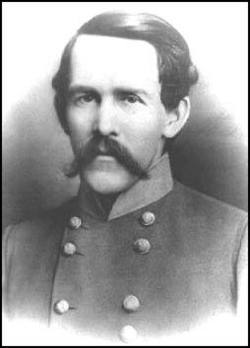The Curmudgeon, The Eccentric, and the “Norse God”: How Three Men Impacted the Battle of Gettysburg: Part Seven
Lee’s Bad Old Man Takes the Field:

At the outset of the Chancellorsville Campaign, Major General Jubal A. Early was the junior ranking division commander in Lee’s army. By the time he arrived at Gettysburg on July 1st he was the senior division commander in Ewell’s Second Corps.
Born in 1816, Jubal A. Early was a West Point graduate of the class of 1837, which included such luminaries as Joseph Hooker, John Sedgwick, and Robert Chilton. Early had left the army to pursue a career as a lawyer and politician in Virginia. Although he voted against the secession of Virginia, he soon embraced the Confederate cause. Initially Early—who became known as “Old Jube”- commanded the 24th Virginia, but he quickly rose to brigade command. He saw action at Williamsburg, where he was wounded, Malvern Hill, Cedar Mountain, and Second Manassas. During the Sharpsburg campaign, he took the reins of a Confederate division. In that capacity at Fredericksburg, he earned distinction—and risked earning the ire of his commander, Stonewall Jackson—by disregarding an order so that he could protect the Confederate right flank, a decision that, some said, saved Jackson’s line.
Lee playfully referred to Early as “my bad old man.” Reportedly, Early was the only Confederate officer in the Army of Northern Virginia with the temerity to curse in Lee’s presence. John Brown Gordon, who served as a general officer under Early, described his commander as “a bachelor, with a pungent style of commenting on things he did not like; but he had a kind heart and was always courteous to women.”
Unlike Lee and Jackson, though, Early drank, cursed, and was not a religious man. Lee’s adjutant, Colonel Walter Taylor, wrote of Old Jube to his fiancée, “Don’t tell anyone I say so, but I have feared our friend Early would not accomplish much because he is such a Godless man. He is a man who utterly sets at defiance all moral laws & such a one Heaven will not favour.”
“Early was undoubtedly one of the strongest and ablest of Lee’s lieutenants,” observed Confederate artillerist Maj. Robert Stiles:
He was not perhaps the brilliant and dashing soldier that A. P. Hill was, nor a superb, magnetic leader like Gordon, and possibly he could not deliver quite as a majestic blow in actual battle as Longstreet; but his loyal devotion, his courage, his native intellect, his mental training, his sagacity, his resource, his self-reliant, self-directing strength, were all very great, and the commanding general reposed the utmost confidence in him.
******

Early’s 5,158 foot soldiers, and 16 cannon, had made their way through the Gettysburg area on June 26, when Old Jube held the town for ransom. Moving on from the area, Early’s men had reached the banks of the Susquehanna River before being recalled by Ewell and Lee.
When Richard Ewell broke his corps into three pieces, Ewell ordered Early’s division to approach Gettysburg via the Harrisburg Road. The marching route, though slightly more circuitous than Rodes line of march to Gettysburg, brought Early’s men onto the battlefield from the northeast, and unwittingly on the right flank of the Federal army.
The Federal 11th Corps arrived in Gettysburg late on the morning of July 1st. Their acting commander, Major General Carl Schurz, ordered two of his three divisions to the north of the town. Schurz’s division, now today commanded by Brigadier General Alexander Schimmelfennig, loosely linked with the right flank of the 1st Corps and extended a thin battleline east to the Carlisle Road. Brigadier General Francis C. Barlow’s undersized division picked up the Federal line and extended it to the Carlisle Road.
Sometime after 2 PM, Early’s division arrived essentially undetected on the field. The curmudgeon deployed 12 cannon of Lieutenant Colonel Hilary P. Jones’ battalion of artillery to the left of the Harrisburg Road (to the left as you approach Gettysburg). Early then deployed his largest brigade, six Georgia regiments commanded by Brigadier General John B. Gordon. These 1,813 men deployed to the right of the Harrisburg Road, with the exception of the 26th Georgia, who were held back in support of Jones’ cannon. The infantry fixed their gaze on the sizeable hill to their front, Blocher’s Knoll (today known as Barlow’s Knoll).

The southern artillerymen focused their fire on the crest of Blocher’s Knoll. To counter the fire, four guns of Lieutenant Bayard Wilkeson’s Battery G 4th United States Artillery, were deployed and began dueling with effect with the southern guns.
At Oak Hill Robert Rodes heard Early’s cannon reverberate across the plain. Quickly he scribbled a note to his fellow division commander:
“Heth and Pender are in Reynolds’ front. I can burst through the enemy in an hour.”
Rodes, Major-General.
Rodes, whose earlier assaults on Oak Ridge had failed miserably, looked to renew the action and accomplish what he had set out to do, roll the 1st Corps flank up.
Jubal Early was not one to mince words. “All right burst through.” was his curt response. Thus, the Second Corps offensive was renewed with vigor.
Early set his men to work in two waves. The first would simply consist of five of Gordon’s regiments. The second, trailing wave, consisted Brigadier General Harry Hays’ Louisiana brigade and three North Carolina regiments headed by Colonel Isaac Avery.
As Gordon’s men rolled forward toward Rock Creek, Blocher’s Knoll, and the Federal flank more Confederates joined the fray.